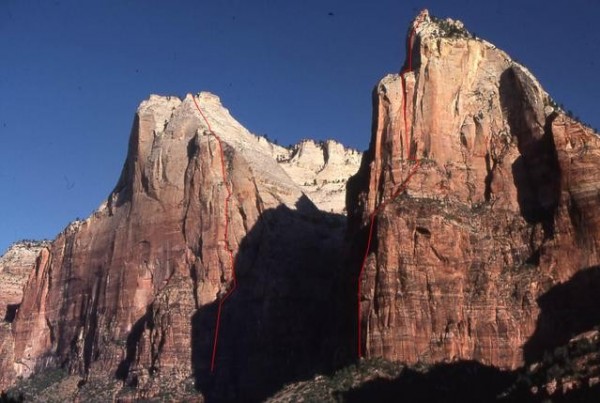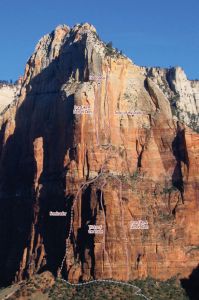This story first appeared in the 1972 issue of Ascent. I'm going to include it as one of two stories in the book I'm working on, illustrating the experience of the classic old style of mixed free and aid climbing on big walls. In addition to the stories, this section of the book will have a guide to about 30 aid climbs, done during the period 1967 through 1973, which will be titled The Big-wall Era. After that time, I abandoned aid climbing altogether in favor of free climbing.
ZION: A SACRED PLACE
The Ascent of Isaac in the Court of the Patriarchs
The roadside plaque reads: Jacob, Isaac and Abraham – The Three Patriarchs. Isaac, between Jacob and Abraham, soars up all craggy steep to a narrow, pointed summit. It seems friendlier to the climber than the suave aloofness of Jacob, and, really, Abraham is a fat old man who can’t see his own toes. Across the way is the “Toad”, my own term, actually, for a chameleon-like character who in the wink of an eye can change from the Stalwart Southern Guardian of the Court of the Patriarchs into a Despicable Beast, spitting dirt and bushes on you in the most disgusting manner imaginable. If you’d been there like I was, you’d have wished you were on Isaac, instead, like I did…
We’re climbing in what must be the intestine, winding our way through the recesses of a chimney so deep that there is not even enough light to take pictures. At first, the chimney is a twelve-inch slot, into which Wick and I must squeeze our bodies, squirming to gain purchase on the smooth sandstone. Our struggles match those of Mike and John, who are in the lead for the day. At the end of each pitch we clip into their belay bolt. In the lower chimney we have some difficulty hauling our sack and Wick must constantly dislodge it as he follows. Higher, the chimney widens and sack hauling is no problem, but as we look up through the eerie gloom the crack seems to yawn too wide. A questioning shout bounces off the rock but Mike assures us from above that the chimney still goes. By stemming between the narrowest undulations of these dark walls, we find the climbing still reasonable, though scary, and continue at a fair pace.
However, the intestine is lengthy, and for most of the day Isaac hides us in his bowels, until at last John leads us through a constricted, dirty tunnel, and the four of us burst out into light.
The light appears to us as it must to a coal miner up from a day’s work half a mile underground. The sun, low down between the Toad and Jacob, gives a warm yellow life to the things on the First Ledge: the prickly pear, the manzanita, the yucca, us. The light gives depth to the air below us, and detail to the things around us. Our shadows give weight to our conviction that we exist. See there: we block the rays of the sun. We are up from down below, where life is not quite real, but closer to a dream.
Routes on Jacob (George and Jerff Lowe, 1972),left, and Isaac (Jeff Lowe, Mike Weis, John Weiland and Wick Beavers, 1971), right.
As we follow the setting sun up between the First and Second Ledges, our minds are eased by the texture of the soft red sandstone. It’s more like a lover’s ass than cold stone, and a gentle caress, not a forceful tug, gets us where we want to go. As the color of the rock blushes to a glowing pink in the sunset, we begin to accept the offerings that emanate from the things around us.
Night finds us drinking Coors around a campfire on the brushy Second Ledge. Four pairs of eyes reflect the fire and blink like stars in the blue-black night. A thousand feet up the southeastern flank of a mountain named Isaac in the southern Utah canyon named Zion, four voices fill a corner of rock that until now was only distantly aware of men.
“Ahhh, damn that beer tastes good.”
“Pass the peanuts will ya, John.”
“Man, Zion’s really great.”
“There’s just too many damn people in the Valley.”
"In five years this place will be just as crowded."
“Christ, I hope not, maybe we oughta keep it quiet.”
The comfort of the fire makes us reluctant to sleep. A full moon rises while the talk flows on. Far below, the Virgin River mumbles a quiet protest under her breath. Gentle winds carry her whispered worry for her creation to the ears of those who care.
In the February crystal-sparkling Zion morning, we emerge like four young butterflies from down cocoons. Our spirits fly but our bodies are left behind to deal with the cracks of the Tower. Unhampered by pieces of sling and bits of iron, we worm our way up the freedom of a four-inch crack. Fingers curled tight, we conserve our strength by using our fists like nuts in narrow places. The idea is to keep moving; hang around and you soon grow tired. The crack is a ladder with invisible rungs; concentrate, concentrate deeply and you feel them under your feet. Free-climbing, we learn something. We live our lives looking for extremes and loving ease. The rhythm of contrast is the heartbeat of our being. We are like caterpillars on a red-barked tree, inching toward the Change; the more complete we make our cocoon of life, the healthier the butterfly.
On top of the Tower, between parapet walls of sandstone, we begin our evening feast. This climb is different than most, with a campfire every night. As we drink our Golden, Colorado brew, Wick the Jester’s shadow flickers twenty-five feet tall on the headwall above. Tonight the four of us must live out this fantasy. With Isaac, King of Nature as our host, we have a quiet party on the summit of the Tower. In this stark, open hall with a giant pine leaning like a fallen rafter from the roof of some medieval castle, we feel a sad nostalgia for simpler times, when life was enough without inventing games.
In the first rays of the morning sun, the upper headwall is a beaming yellow face. The sun shines brighter, but the light against Isaac stays mellow, rich, easy to look at as John starts to climb up a crack that smiles from the wall. To begin with, the lips are tight, and John inserts a ladder of pins. Later, slowly, he enters the toothless grin and hands and feet take over from the nails. With the sluggishness of a warm-blooded animal in the sun after a chilly night, John climbs on past a tongue of rock hanging from the mouth.
Waiting for our turn, Wick and I lay like sunning lizards on the ledge. We watch as, high above us, Mike climbs an overhanging nose. The nostril’s too wide for pitons so up he goes, shinnying and jamming as best he can. With a few final grunts and an extra-hard heave, he’s over at last. A sigh, almost great enough to be from Isaac himself, rushes though the air. Now it’s time for Wick and me to follow the leaders, upwards through the shining winter day.
As the afternoon purples with sunset, I make a solitary scramble to the summit along a weathered ridge. For the other three, the climb was over when Mike and John led us out the upper corner of the smiling yellow headwall. They feel no need in the lessening light to make a dash for the top-most point. But Isaac’s untouched summit creates a vacuum in my mind that sucks me on and on until I’m there. Obnoxious, soulless, snot-nosed kid, I build a cairn at the very top. Father Isaac stands tolerant still, but not me, only my ego is triumphant. I shuffle back down the ridge and join the others at our bivouac-camp, my steps made heavy by a small stack of stones that weighs on my heart.
Night fades.
Dawn breaks.
Darkness leaves my conscience and new rays fill my soul. My ego made me build the cairn and, curiously, made me suffer by deceiving me into believing I was above my human failings. I brush wind-blown grains of sand off my sleeping bag and spring up in the sun-scrubbed, hope-filled morning to greet the day and the descent.
The descent flows smoothly down backside sloping slabs. We scramble down easier parts, and evergreens hold the rope for us to slide over the steep. The sweeping white ridge of Abraham hides us from the eyes of man and nothing man-made mars our view. We are the first ones here in these hanging canyons on hanging canyons, and there is a hushed and reverent silence as we round corners of the unknown past. Here we find a perfect carpet of green moss growing precariously on a sandy bottom. We make the mistake of trampling on the fragile lawn, our feet crushing and indenting nature’s floor. Well-meaning men, we are the first to leave our destructive mark on this wild place. The next bend reveals the treasure of a million diamonds scattered on the canyon floor. Looking up shaded walls, we see the frozen waterfall whence they’ve fallen. Around the last corner, in the lowest hanging canyon, Mike speeds ahead through a water-carved gorge, under a mammoth, wedged stone, then waits, poised in peaceful, ancient light, still three hundred feet above the world of men.

